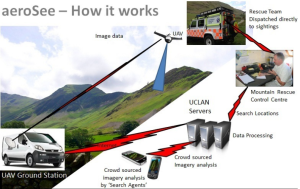
LOOMIO is free and open-source software for anyone, anywhere, to participate in decisions that affect them.
“The world needs a better way to make decisions together. #Loomio is building it. You can help: http://thndr.it/1kaQhmy”

LOOMIO is free and open-source software for anyone, anywhere, to participate in decisions that affect them.
“The world needs a better way to make decisions together. #Loomio is building it. You can help: http://thndr.it/1kaQhmy”

Using Social Media to Predict Economic Activity in Cities
Economic indicators in most developing countries are often outdated. A new study suggests that social media may provide useful economic signals when traditional economic data is unavailable. In “Taking Brazil’s Pulse: Tracking Growing Urban Economies from Online Attention” (PDF), the authors accurately predict the GDPs of 45 Brazilian cities by analyzing data from a popular micro-blogging platform (Yahoo Meme). To make these predictions, the authors used the concept of glocality, which notes that “economically successful cities tend to be involved in interactions that are both local and global at the same time.” The results of the study reveals that “a city’s glocality, measured with social media data, effectively signals the city’s economic well-being.”

Essay of the Day: The Peer Production of Large-Scale Networked Protests
* Special Journal Issue: Organization in the crowd: peer production in large-scale networked protests. By W. Lance Bennett, Alexandra Segerberg & Shawn Walker. Information, Communication & Society. Volume 17, Issue 2, 2014, pages 232-260. Special Issue: The Networked Young Citizen.
From the Abstract:
 “How is crowd organization produced? How are crowd-enabled networks activated, structured, and maintained in the absence of recognized leaders, common goals, or conventional organization, issue framing, and action coordination? We develop an analytical framework for examining the organizational processes of crowd-enabled connective action such as was found in the Arab Spring, the 15-M in Spain, and Occupy Wall Street. The analysis points to three elemental modes of peer production that operate together to create organization in crowds: the production, curation, and dynamic integration of various types of information content and other resources that become distributed and utilized across the crowd. Whereas other peer-production communities such as open-source software developers or Wikipedia typically evolve more highly structured participation environments, crowds create organization through packaging these elemental peer-production mechanisms to achieve various kinds of work. The workings of these ‘production packages’ are illustrated with a theory-driven analysis of Twitter data from the 2011–2012 US Occupy movement, using an archive of some 60 million tweets. This analysis shows how the Occupy crowd produced various organizational routines, and how the different production mechanisms were nested in each other to create relatively complex organizational results.”
“How is crowd organization produced? How are crowd-enabled networks activated, structured, and maintained in the absence of recognized leaders, common goals, or conventional organization, issue framing, and action coordination? We develop an analytical framework for examining the organizational processes of crowd-enabled connective action such as was found in the Arab Spring, the 15-M in Spain, and Occupy Wall Street. The analysis points to three elemental modes of peer production that operate together to create organization in crowds: the production, curation, and dynamic integration of various types of information content and other resources that become distributed and utilized across the crowd. Whereas other peer-production communities such as open-source software developers or Wikipedia typically evolve more highly structured participation environments, crowds create organization through packaging these elemental peer-production mechanisms to achieve various kinds of work. The workings of these ‘production packages’ are illustrated with a theory-driven analysis of Twitter data from the 2011–2012 US Occupy movement, using an archive of some 60 million tweets. This analysis shows how the Occupy crowd produced various organizational routines, and how the different production mechanisms were nested in each other to create relatively complex organizational results.”

New Insights on How To Verify Social Media
The “field” of information forensics has seen some interesting developments in recent weeks. Take the Verification Handbook or Twitter Lie-Detector project, for example. The Social Sensor project is yet another new initiative. In this blog post, I seek to make sense of these new developments and to identify where this new field may be going. In so doing, I highlight key insights from each initiative.
The co-editors of the Verification Handbook reminds us that misinformation and rumors are hardly new during disasters. Chapter 1 opens with the following account from 1934:

Crisis Mapping without GPS Coordinates
I recently spoke with a UK start-up that is doing away with GPS coordinates even though their company focuses on geographic information and maps. The start-up, What3Words, has divided the globe into 57 trillion squares and given each of these 3-by-3 meter areas a unique three-word code. Goodbye long postal addresses and cryptic GPS coordinates. Hello planet.inches.most. The start-up also offers a service called OneWord, which allows you to customize a one-word name for any square. In addition, the company has expanded to other languages such as Spanish, Swedish and Russian. They’re now working on including Arabic, Chinese, Japanese and others by mid-January 2014. Meanwhile, their API lets anyone build new applications that tap their global map of 57 trillion squares.
When I spoke with CEO Chris Sheldrick, he noted that their very first users were emergency response organizations. One group in Australia, for example, is using What3Words as part of their SMS emergency service. “This will let people identify their homes with just three words, ensuring that emergency vehicles can find them as quickly as possible.” Such an approach provides greater accuracy, which is vital in rural areas. “Our ambulances have a terrible time with street addresses, particularly in The Bush.” Moreover, many places in the world have no addresses at all. So What3Words may also be useful for certain ICT4D projects in addition to crisis mapping. The real key to this service is simplicity, i.e., communicating three words over the phone, via SMS/Twitter or email is far easier (and less error prone) than dictating a postal address or a complicated set of GPS coordinates.

Using Crowd Computing to Analyze UAV Imagery for Search & Rescue Operations
My brother recently pointed me to this BBC News article on the use of drones for Search & Rescue missions in England’s Lake District, one of my favorite areas of the UK. The picture below is one I took during my most recent visit. In my earlier blog post on the use of UAVs for Search & Rescue operations, I noted that UAV imagery & video footage could be quickly analyzed using a microtasking platform (like MicroMappers, which we used following Typhoon Yolanda). As it turns out, an enterprising team at the University of Central Lancashire has been using microtasking as part of their UAV Search & Rescue exercises in the Lake District.

Every year, the Patterdale Mountain Rescue Team assists hundreds of injured and missing persons in the North of the Lake District. “The average search takes several hours and can require a large team of volunteers to set out in often poor weather conditions.” So the University of Central Lancashire teamed up with the Mountain Rescue Team to demonstrate that UAV technology coupled with crowdsourcing can reduce the time it takes to locate and rescue individuals.

Crisis Mapping in Areas of Limited Statehood
I had the great pleasure of contributing a chapter to this new book recently published by Oxford University Press: Bits and Atoms: Information and Communication Technology in Areas of Limited Statehood. My chapter addresses the application of crisis mapping to areas of limited statehood, drawing both on theory and hands-on experience. The short introduction to my chapter is provided below to help promote and disseminate the book.
Continue reading “Patrick Meier: Crisis Mapping in Areas of Limited Statehood”